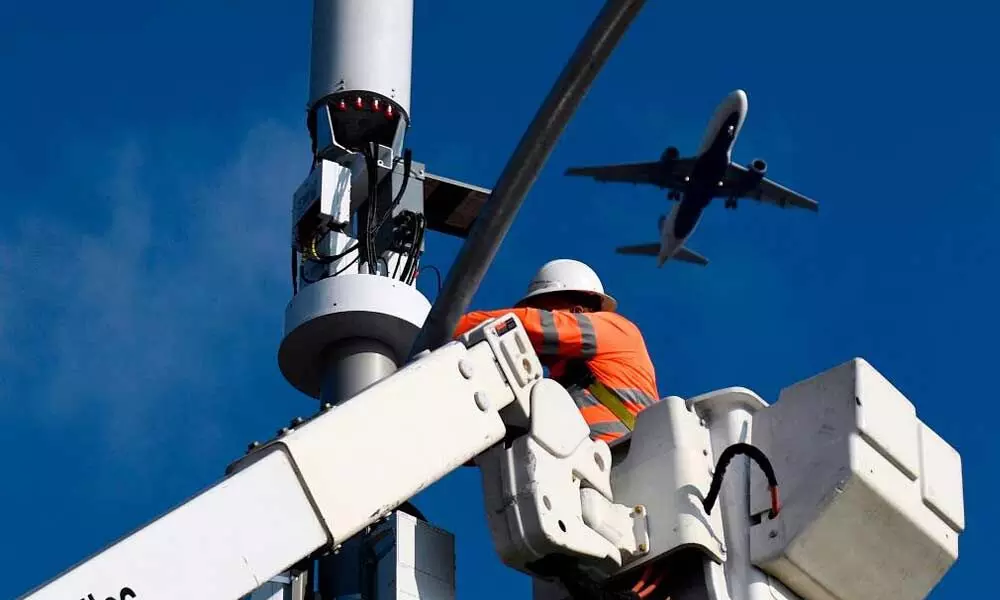FAA allows 78% of US commercial fleet to land where 5G uses C-band
The FAA is working diligently to determine which altimeters are reliable and accurate where 5G is deployed in the United States
image for illustrative purpose

The Federal Aviation Administration (FAA) issued new approvals that allow an estimated 78 per cent of the US commercial fleet to perform low-visibility landings at airports where wireless companies deployed 5G C-band. This now includes some regional jets.
Airplane models with one of the 13 cleared altimeters include all Boeing 717, 737, 747, 757, 767, 777, 787, MD-10/-11; all Airbus A300, A310, A319, A320, A330, A340, A350 and A380 models; and some Embraer 170 and 190 regional jets. The FAA is working diligently to determine which altimeters are reliable and accurate where 5G is deployed in the United States. We anticipate some altimeters will be too susceptible to 5G interference. To preserve safety, aircraft with those altimeters will be prohibited from performing low-visibility landings where 5G is deployed because the altimeter could provide inaccurate information.
A new safety buffer around airports in the 5G deployment further expanded the number of airports available to planes with previously cleared altimeters to perform low-visibility landings. The FAA has cleared another three altimeters. Even with these approvals, flights at some airports may still be affected. The FAA also continues to work with manufacturers to understand how radar altimeter data is used in other flight control systems.
"We recognize the economic importance of expanding 5G, and we appreciate the wireless companies working with us to protect the flying public and the country's supply chain. The complex US airspace leads the world in safety because of our high standards for aviation, and we will maintain this commitment as wireless companies deploy 5G," said Pete Buttigieg, US Transportation Secretary.
With safety as its core mission, the FAA will continue to ensure that the travelling public is safe as wireless companies deploy 5G. The FAA continues to work with the aviation industry and wireless companies to try to limit 5G-related flight delays and cancellations.
The agency approved two radio altimeter models that are installed in a wide variety of Boeing and Airbus planes. This combination of aircraft and altimeter approval opens up runways at as many as 48 of the 88 airports most directly affected by 5G C-band interference. The wireless companies agreed to create buffer zones for six months around airports where transmitters are in close proximity. They also agreed to delay deployment until Jan. 19 while the FAA reviewed new data detailing the location and power of wireless transmitters in all 46 US markets where this service will be deployed.
Even with these new approvals, flights at some airports may still be affected. The FAA also continues to work with manufacturers to understand how radar altimeter data is used in other flight control systems.
During the two-week delay in deploying new 5G service, safety experts determined that 5G interference with the aircraft's radio altimeter could prevent engine and braking systems from transitioning to landing mode, which could prevent an aircraft from stopping on the runway.
The Airworthiness Notification requires crews to be aware of this risk and to adopt specific safety procedures when landing on these runways. The directive affects 137 aircraft in the United States and 1,010 worldwide.
The FAA is working to determine which radar altimeters will be reliable and accurate with 5G C-Band deployed in the United States. Since the agreement with the wireless companies was reached, the agency has made progress to safely reduce the risk of delays and cancellations as wireless companies share more data and manufacturer altimeter testing results arrive. The FAA expects to provide updates soon about the estimated percentage of commercial aircraft equipped with altimeters that can operate reliably and accurately in the 5G C-Band environment. Aircraft with untested altimeters or that need retrofitting or replacement will be unable to perform low-visibility landings where 5G is deployed. The Federal Aviation Administration released the list of 50 airports that will have buffer zones when wireless companies turn on new 5G C-band service on January 19. The agency sought input from the aviation community where the proposed buffer zones would help reduce the risk of disruption. Traffic volume, the number of low-visibility days and geographic location are factored into the selection.
Many airports are not currently affected by the new 5G deployment, even though they are not on this list. These include airports not in the 46 markets where the new service will be deployed and airports that do not currently have the ability to allow low-visibility landings.
The wireless companies agreed to turn off transmitters and make other adjustments near these airports for six months to minimize potential 5G interference with sensitive aircraft instruments used in low-visibility landings. The FAA continues to work with the aerospace manufacturers and wireless companies to make sure 5G is safely deployed and to limit the risk of flight disruptions at all airports.

